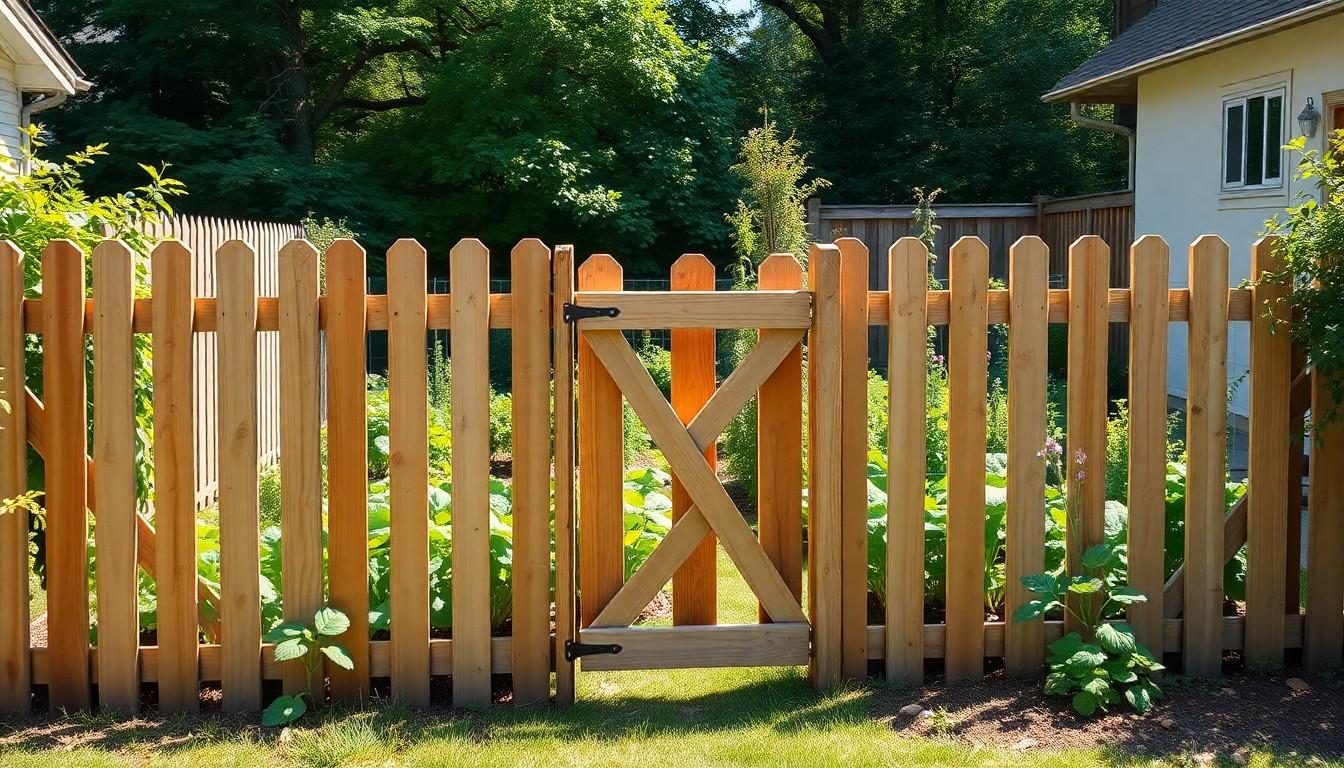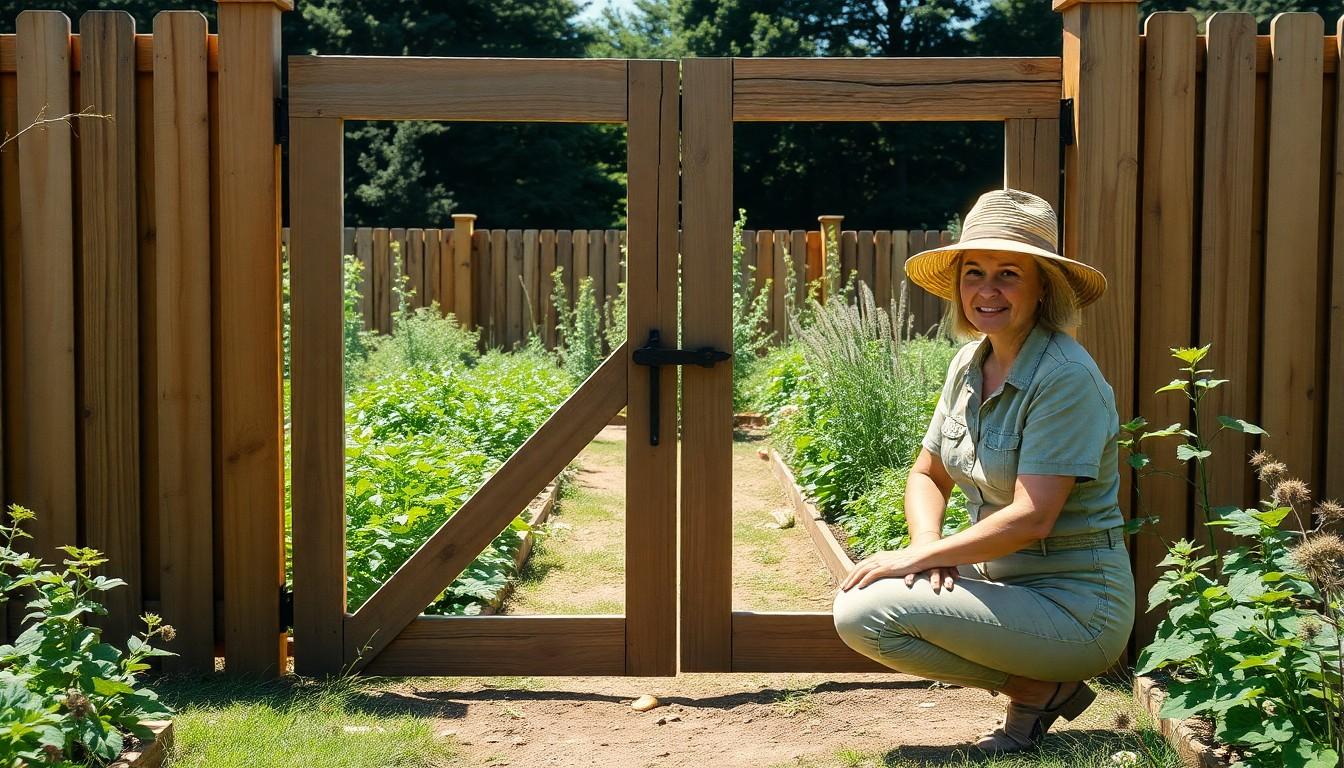Every gardener knows the struggle of keeping pesky critters out of their prized vegetable patch. Imagine planting the perfect tomatoes only to find a family of rabbits throwing a feast. Enter the vegetable garden fence with a gate—your garden’s new best friend. Not only does it keep the munching marauders at bay, but it also adds a charming touch to your outdoor oasis.
Overview Of Vegetable Garden Fence With Gate
A vegetable garden fence with a gate serves multiple functions. It protects crops from animals, such as rabbits, deer, and pests that might otherwise destroy hard work. This barrier offers a secure space for growing vegetables while also enhancing the overall garden landscape.
Various materials suit different garden aesthetics and budgets. Wood, vinyl, and wire options provide choices that align with preferences. Wooden fences deliver a classic look but may require maintenance. In contrast, vinyl options offer longevity and low upkeep. Wire fences, though economical, may need additional support for height.
Height plays a crucial role in fencing effectiveness. A fence at least 3 to 6 feet tall prevents most animals from hopping over. Digging creatures can be deterred with underground barriers made of wire or concrete.
Gate design also contributes to functionality and access. Using a reliable locking mechanism secures the gate, ensuring animals cannot enter. Additionally, consider using a wide enough gate for easy access with tools, carts, or plants.
Installation requires careful planning. Establishing posts deep in the ground ensures durability against weather elements. While installing, ensure measurements align with property boundaries and local regulations.
Customizing the fence allows for both security and flair. Gardeners may choose colors, styles, and additional features like climbing plants or decorative edges. These enhancements not only increase visual appeal but also blend the fence into the natural landscape.
Selecting an appropriate fence significantly impacts garden productivity. Investing in a sturdy vegetable garden fence with a gate paves the way for a thriving, protected garden space.
Benefits Of Using A Fence With A Gate

A vegetable garden fence with a gate offers numerous advantages for gardeners. Enhanced security and pest protection remain among the top reasons to consider this structure.
Security For Your Plants
A secure fence deters unwanted visitors from entering the garden. It creates a barrier around plants, which significantly reduces the likelihood of theft or vandalism. An added layer of protection comes from a locked gate, ensuring easy access for the gardener while keeping intruders out. Choosing a robust material like vinyl or sturdy wood strengthens this security. Height plays a critical role as well; a fence measuring 3 to 6 feet tall can prevent larger animals from jumping over. Proper installation techniques further improve overall security, creating a safer environment for plants to thrive.
Protection Against Pests
Insects and rodents pose a constant threat to vegetable gardens. Fencing effectively keeps these pests at bay, reducing the damage they can cause to crops. A well-constructed fence prevents animals like rabbits, deer, and raccoons from entering the garden space. Incorporating an underground barrier extends protection against digging creatures as well. Customizing the gate ensures it closes securely, providing an additional defense against pests. Regular maintenance, including checking for any gaps or weaknesses, helps maintain this protective shield. By establishing a secure perimeter, gardeners maximize their chances of a successful harvest.
Types Of Vegetable Garden Fences
Different types of vegetable garden fences cater to various needs and preferences. They offer distinct advantages in protecting crops and enhancing garden aesthetics.
Wooden Fences
Wooden fences present a classic and natural look. They provide robust protection against pests while blending seamlessly into the landscape. Different wood types such as cedar and redwood resist rot and pests. Heights range from 3 to 6 feet, effectively deterring deer and other larger animals. With proper maintenance, wooden fences can withstand various weather conditions. Gardeners often preference treated wood for added durability. Custom designs allow for creativity in appearance and functionality, making wooden fences a popular choice.
Metal Fences
Metal fences, often constructed from materials like chain-link or wrought iron, deliver superior strength. They effectively deter various animals due to their durability and height options. Metal fencing provides a modern aesthetic, complementing contemporary garden designs. Many gardeners appreciate the low maintenance required; these fences resist factors like rot and corrosion. Choosing galvanized metal prevents rusting and extends the fence’s lifespan. Installing them with a secure foundation enhances stability and security, vital for protecting vegetable gardens.
Vinyl Fences
Vinyl fences represent a versatile and long-lasting fencing option. They offer a variety of colors and styles, appealing to aesthetic preferences. Resistance to fading and weather damage makes vinyl low maintenance. Vinyl doesn’t warp, split, or require painting, which attracts many gardeners. Typical heights range from 4 to 6 feet, providing adequate protection against animals. Easy installation allows for quick setup without professional assistance. Furthermore, vinyl fences are eco-friendly, contributing to sustainable gardening practices.
Choosing The Right Gate For Your Garden
Selecting the ideal gate for a vegetable garden requires attention to size, style, and materials. A well-chosen gate enhances both functionality and overall garden aesthetics.
Size And Style Considerations
Starting with size, the gate should match the vegetable garden’s dimensions and layout. An appropriate width of 36 to 48 inches suits most access needs, accommodating tools and carts. Height is equally important; a height of 5 to 6 feet deters many animals while keeping a coherent look with the surrounding fence. In terms of style, options range from classic to modern designs. Choosing a style that complements the garden’s theme reinforces visual appeal and creates a cohesive landscape.
Material Options
Various gate materials offer distinct advantages. Wooden gates, crafted from materials like cedar or redwood, provide a natural look and significant durability. They can blend seamlessly with wooden fences. Metal options, including wrought iron and galvanized steel, deliver strength and long-term reliability. These materials often require minimal maintenance and enhance security. Vinyl gates offer weather resistance and customization in color and style, appealing to diverse preferences. Prioritizing the right material ensures a lasting solution that withstands environmental challenges.
Installation Tips For Your Fence And Gate
Installing a vegetable garden fence with a gate involves careful planning and the right tools. Prioritize proper measurements and alignment for a successful installation.
Tools Needed
Gather essential tools before starting the installation. A post hole digger or auger helps create holes for the fence posts. You’ll also need a level to ensure posts remain straight, a tape measure for accurate dimensions, and a hammer for driving in nails or staples. Prying tools like a pry bar assist with setting and adjusting the fence. For cutting materials, a saw suited for your chosen fence type is necessary. Additionally, a drill facilitates securing the gate hardware effectively.
Step-By-Step Installation Guide
Begin by marking the layout of the fence. Use stakes to outline corners and straight sections. Dig holes for the fence posts at regular intervals, typically 6 to 8 feet apart. Set the posts in concrete for stability. Once the posts are secure, attach the fence panels or wire, ensuring it aligns correctly. For the gate, install hinges on the posts and attach the gate securely. Complete the installation by adding a latch for easy access and security. Regularly check alignment and tightness to maintain fence integrity.
Maintenance Tips For Longevity
Regular maintenance ensures a vegetable garden fence with gate remains effective and visually appealing. Inspect the fence and gate frequently for signs of wear, rot, or damage. Wooden components often require more attention, as moisture can lead to deterioration. Seasonal treatments, such as sealing or staining wood, protect against the elements and prolong lifespan.
For metal fences, check for rust or corrosion. Applying a protective coating can safeguard against moisture and extend durability. Gates may need lubrication on hinges to facilitate smooth operation. This simple step prevents squeaks and allows for easy access.
Adjustments to the gate should occur periodically. Ensure the latch aligns correctly and maintains secure closure. Address any gaps between the fence and the ground to prevent small animals from sneaking in. Adding gravel or compacting soil can create a sturdy underground barrier.
Weeds can damage both the aesthetics and integrity of the fence. Regularly clear the area around the fence and gate to maintain a tidy appearance and prevent critters from using vegetation as cover. Proper vegetation management enhances visibility for more effective monitoring.
Planning for seasonal changes helps maintain functionality. Snow and ice accumulation during winter may pose challenges. Clearing pathways and maintaining fence lines can prevent unnecessary strain on structures.
Ultimately, straightforward care routines contribute to a thriving vegetable garden. Rigorous maintenance methods maximize protection against pests and enhance the garden’s overall aesthetics. Consistent checks and timely upkeep create a lasting barrier for successful gardening.
Conclusion
A vegetable garden fence with a gate is an invaluable investment for any gardener. It not only protects crops from pests but also enhances the garden’s overall aesthetic. Choosing the right materials and ensuring proper installation can significantly improve security and functionality.
Regular maintenance is essential to keep the fence and gate in optimal condition, safeguarding the garden from potential threats. By prioritizing these elements, gardeners can enjoy a thriving vegetable garden that stands resilient against wildlife while remaining visually appealing. With the right approach, a well-designed fence and gate can transform a garden into a secure and beautiful sanctuary for growing fresh produce.

